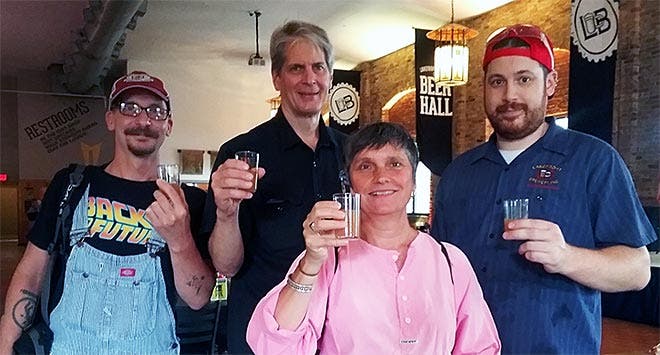Archaeologists recreated an Iron Age brew buried with the dead 2,500 years ago, and it tastes “very cool”.

Back in 2000, University of Wisconsin-Milwaukee archaeologist and anthropologist Bettina Arnold was examining a burial plot from 400 or 450 B.C. in what is today Germany. Inside, she stumbled upon a portly bronze cauldron. After analyzing the remnants on the vessel’s walls, she and a team of local craft brewers brought the drink back from the dead.
Dig first, drinks later
The plot Arnold was investigating is called a tumulus from the Latin word for “little hill”. It looks like a mound of earth and cut stones built over a grave, and they’re usually indicative of a noble or rich person’s burial place. It was built sometime in the 7th to 5th centuries BC in today’s Swabia, Germany, and by the time Arnold began investigating it the skeleton was nowhere to be found, likely dissolved by the acidic soil. It was most likely a male, though, as the archaeologists found an iron sword, a helmet, and two long iron spears buried inside the tumulus.
Archaeologists also found a bronze pot or cauldron inside, which Arnold chalks up to one of the best reasons for having a drink handy I’ve ever heard.
“The dead man in Tumulus 17 Grave 6 had been sent into the afterlife not only with his weapons but with about 14 litres of an alcoholic beverage that he could have used to establish himself as an important person in the next world as he had been in this one,” she explains on her blog.
Turns out the afterlife is a lot like college. Arnold says the cauldron contained roughly 14 liters (3.7 gallons) of fairly high-quality liquid — but it’s had a few thousand years to age, so it had a particularly un-drinklike form when she found it. A paleobotanical analysis of the vessel’s contents created a basic run-down of the ingredients in the brew’s recipe.
“Luckily for us, they didn’t just send people off to the afterlife with [weapons] — they also sent them off with the actual beverage. It’s a BYOB afterlife, you know? You have to be able to sort of throw a party when you get there,” she told Bonnie North at the NPR.
“We actually were able, ultimately, to derive at least some sense of what the contents were in a bronze cauldron,” says Arnold. “The honey, which is definitely present … and then as a bittering and preservative agent — not hops … but meadowsweet,” she explained.

Image credits Bettina Arnold.
Besides yeast, the brew is made up of barley, honey and meadowsweet. Mint was also identified in the drink.
But science is all about getting to know the great unknown. So Arnold enlisted the aid of Milwaukee’s Lakefront Brewery to try and re-do the brew, using the ingredients identified in the cauldron. Lakefront cellarmaster Chad Sheridan’s expertise in home brewing meads and similar drinks helped re-create the process. As he explains, the drink was likely a braggot — “a blend of barley and honey as the two sugar ingredients to create the beverage.”
“I got to sip the final product,” writes Bonnie North at the NPR. “The result was smooth and pleasant — almost like a dry port, but with a minty, herbal tinge to it. It also packed an alcoholic kick.”
Sadly, it’s unlikely we’ll find this ancient pick-me-up on grocery shelves anytime soon.
“[While the drink is] very cool to taste … I don’t think people would be interested in purchasing it to drink,” says Lakefront Brewery’s Chris Ranson. “But it sure was a fun experiment.”
“[Our] version would have been significantly cleaner than the prehistoric one, but we did succeed in producing something that provides those of us with jaded modern palates with a very different flavour profile,” her blog post reads. “The mint actually came through first, which was unexpected, followed by the slightly astringent meadow sweet, but the honey was barely in evidence (having been almost completely converted to alcohol).”
With all that honey converted into alcohol, the drink also packs quite a sizable punch.
“With an [alcohol by volume] of over 8 percent, this is not your grannie’s braggot,” Arnold goes on to say, “and although adding honey at this stage would probably make it more drinkable for [today’s] mead imbibers, we decided to leave it as is.”
But the braggot seems to have done the trick for Arnold, who hopes this is just the first re-creation of many to come. She said the UWM’s College of Letters and Science is working on a program focusing on the cultural and scientific elements of fermentation. In the future, she says, she’ll be developing a course where ancient recipes and archaeological evidence are used to brew up different drinks. Cheers to that!
Was this helpful?



